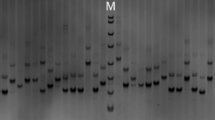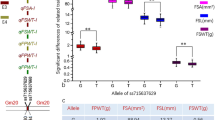Abstract
Association mapping is an alternative to mapping in a biparental population. A key to successful association mapping is to avoid spurious associations by controlling for population structure. Confirming the marker/trait association in an independent population is necessary for the implementation of the marker in other genetic studies. Two independent soybean populations consisting of advanced breeding lines representing the diversity within maturity groups 00, 0, and I were screened in multi-site, replicated field trials to discover molecular markers associated with iron deficiency chlorosis (IDC), a major yield-limiting factor in soybean. Lines with extreme phenotypes were initially screened to identify simple sequence repeat (SSR) markers putatively associated with the IDC. Marker data collected from all lines were used to control for population structure and kinship relationships. Single factor analysis of variance (SFA) and mixed linear model (MLM) analyses were used to discover marker/trait associations. The MLM analyses, which include population structure, kinship or both factors, reduced the number of markers significantly associated with IDC by 50% compared with SFA. With the MLM approach, three markers were found to be associated with IDC in the first population. Two of these markers, Satt114 and Satt239, were also found to be associated with IDC in the second confirmation population. For both populations, those lines with the tolerance allele at both these two marker loci had significantly lower IDC scores than lines with one or no tolerant alleles.


Similar content being viewed by others

References
Blouin MS (2003) DNA-based methods for pedigree reconstruction and kinship analysis in natural populations. Trends Ecol Evol 18:503–511
Blouin MS, Parsons M, LaCaille V, Lotz S (1996) Use of microsatellite loci to classify individuals by relatedness. Mol Ecol 5:393–401
Brady L, Bassett MJ, McClean PE (1998) Molecular markers associated with T and Z, two genes controlling partly colored seed coat patterns in common bean. Crop Sci 38:1073–1075
Breseghello F, Sorrells ME (2006) Association mapping of kernel size and milling quality in wheat (Triticum aestivum L.) cultivars. Genetics 172:1165–1177
Cardon RL, Bell JI (2001) Association study designs for complex disease. Nat Rev Genet 2:91–99
Cavalli-Sforza LL, Edward AWF (1967) Phylogenetic analysis: models and estimation procedure. Evolution 32:550–570
Charlson DV, Cianzio SR , Shoemaker RC (2003) Associating SSR markers with soybean resistance to iron deficiency chlorosis. J Plant Nutr 26:2267–2276
Charlson DV, Bailey TB, Cianzio SR, Shoemaker RC (2005) Molecular marker Satt481 is associated with iron-deficiency chlorosis resistance in a soybean breeding population. Crop Sci 45:2394–2399
Clemens S, Palmgren MG, Kramer U (2002) A long way ahead: understanding and engineering plant metal accumulation. Trends Plant Sci 7:309–315
Falush D, Stephens M, Pritchard JK (2003) Inference of population structure using multilocus genotype data: linked loci and correlated allele frequencies. Genetics 164:1567–1587
Fehr WR (1987) Principles of cultivar development, Volume 1: Theory and technique. McGraw Hill Inc, New York
Gambaro G, Anglani F, D’Angelo A (2000) Association studies of genetic polymorphisms and complex disease. Lancet 355:308–111
Garris A J, McCouch SR, Kresovich S (2003) Population structure and its effect on haplotype diversity and linkage disequilibrium surrounding the xa5 lacus of rice (Oryza sativa L.). Genetics 165:759–769
Gebhardt C, Ballvora A, Walkemeier B, Oberhagemann P, Schüler K (2004) Assessing genetic potential in germplasm collections of crop plants by marker-trait association: a case study for potatoes with quantitative variation of resistance to late blight and maturity type. Mol Breed 13:93–102
Hansen NC, Jolley VD, Naeve SL, Goos RJ (2004) Iron deficiency of soybean in the North Central U.S. and associated soil properties. Soil Sci Plant Nutr 50:983–987
Hardy OJ, Vekemans X (2002) SPAGeDi: a versatile computer program to analyse spatial genetic structure at the individual or population levels. Mol Ecol Notes 2:618–620
Kisha TJ, Diers BW, Hoyt JM, Sneller CH (1998) Genetic diversity among soybean plant introductions and North American germplasm. Crop Sci 38:1669–1680
Kraakman ATW, Niks RE, Van den Berg PMMM, Stam P, Van Eeuwijk FA (2004) Linkage disequilibrium mapping of yield and yield stability in modern spring barley cultivars. Genetics 168:435–446
Lander ES, Botstein D (1989) Mapping Mendelian factors underlying quantitative traits using RFLP linkage maps. Genetics 121:185–199
Lin S, Cianzio S, Shoemaker R (1997) Mapping genetics loci for iron deficiency chlorosis in soybean. Mol Breed 3:219–229
Lin S, Cianzio S, Shoemaker R (2000) Molecular characterization of iron deficiency chlorosis in soybean. J Plant Nutr 23:1929–1939
Liu K, Muse M (2005) PowerMarker: an integrated analysis environment for genetic marker analysis. Bioinformatics 21:2128–2129
Loiselle BA, Sork VL, Nason J, Graham C (1995) Spatial genetic structure of a tropical understory shrub, Psychotria officinalis (Rubiaceae). Am J Bot 82:1420–1425
Pritchard JK, Rosenberg NA (1999) Use of unlinked genetic markers to detect population stratification in association studies. Am J Hum Genet 65:220–228
Pritchard JK, Stephens M, Donnelly P (2000a) Inference of population structure using multilocus genotype data. Genetics 155:945–959
Pritchard JK, Stephens MN, Rosenberg N, Donnelly P (2000b) Association mapping in structured populations. Am J Hum Genet 67:170–181
Queller DC, Goodnight KF (1989) Estimating relatedness using genetic markers. Evolution 43:258–275
Ritland K (1996) Estimators for pairwise relatedness and individual inbreeding coefficients. Genet Res 67:175–186
Rosenberg NA, Burke T, Elo K, Feldman MW, Freidlin PJ, Groenen MAM, Hillel J, Mäki-Tanila A, Tixier-Boichard M, Vignal A, Wimmers K, Weigend S (2001) Empirical evaluation of genetic clustering methods using multilocus genotypes from 20 chicken breeds. Genetics 159:699–713
Semon M, Nielsen R, Jones MP, McCouch SR (2005) The population structure of African cultivated rice Oryza glaberrima (Steud.): evidence for elevated levels of linkage disequilibrium caused by admixture with O. sativa and ecological adaptation. Genetics 169:1639–47
Simko I, Costanzo S, Haynes KG, Christ BJ, Jones RW (2004) Linkage disequilibrium mapping of a Verticillium dahliae resistance quantitative trait locus in tetraploid potato (Solanum tuberosum) through a candidate gene approach. Theor Appl Genet 108:217–224
Staub JE, Danin-Poleg, Fazio G, Horejsi T, Reis N, Katzir (2000) Comparative analysis of cultivated melon groups (Cucumis melo L.) using random amplified polymorphic DNA and simple sequence repeat markers. Euphytica 115:225–241
Szalma S J, Buckler IV ES, Snook ME, McMullen MD (2005) Association analysis of candidate genes for maysin and chlorogenic acid accumulation in maize silks. Theor Appl Genet 110:1324–1333
Thornsberry JM, Goodman MM, Doebley J, Kresovich S, Nielsen D, Buckler IV ES (2001) Dwarf8 polymorphisms associate with variation in flowering time. Nat Genet 28:286–289
Wilkening S, Chen B, Hemminki K, Forst A (2006) STR markers for kinship analysis. Hum Biol 78:1–8
Yu J, Pressoir G, Briggs WH, Vroh Bi I, Yamasaki M, Doebley JF, McMullen MD, Gaut BS, Nielsen DM, Holland JB, Kresovich S, Buckler ES (2006) A unified mixed-model method for association mapping that accounts for multiple levels of relatedness. Nat Genet 38:203–208
Zhu YL, Song QJ, Hyten DL, Van Tassell CP, Matukumalli LK, Grimm DR, Hyatt SM, Fickus EW, Young ND, Cregan PB (2003) Single-nucleotide polymorphisms in soybean. Genetics 163:1123–1134
Acknowledgments
We thank the North Dakota Soybean Council for supporting this research and providing financial assistance to Ju Wang. Special thanks to Edward Buckler IV, Jianming Yu, and Zhiwu Zhang for helpful discussions regarding the mixed linear models analysis. Also, we thank Shahryar Kianian and Marvin Fawley for reviewing the manuscript prior to publication.
Author information
Authors and Affiliations
Corresponding author
Additional information
Communicated by C. Hackett.
Rights and permissions
About this article
Cite this article
Wang, J., McClean, P.E., Lee, R. et al. Association mapping of iron deficiency chlorosis loci in soybean (Glycine max L. Merr.) advanced breeding lines. Theor Appl Genet 116, 777–787 (2008). https://doi.org/10.1007/s00122-008-0710-x
Received:
Accepted:
Published:
Issue Date:
DOI: https://doi.org/10.1007/s00122-008-0710-x



